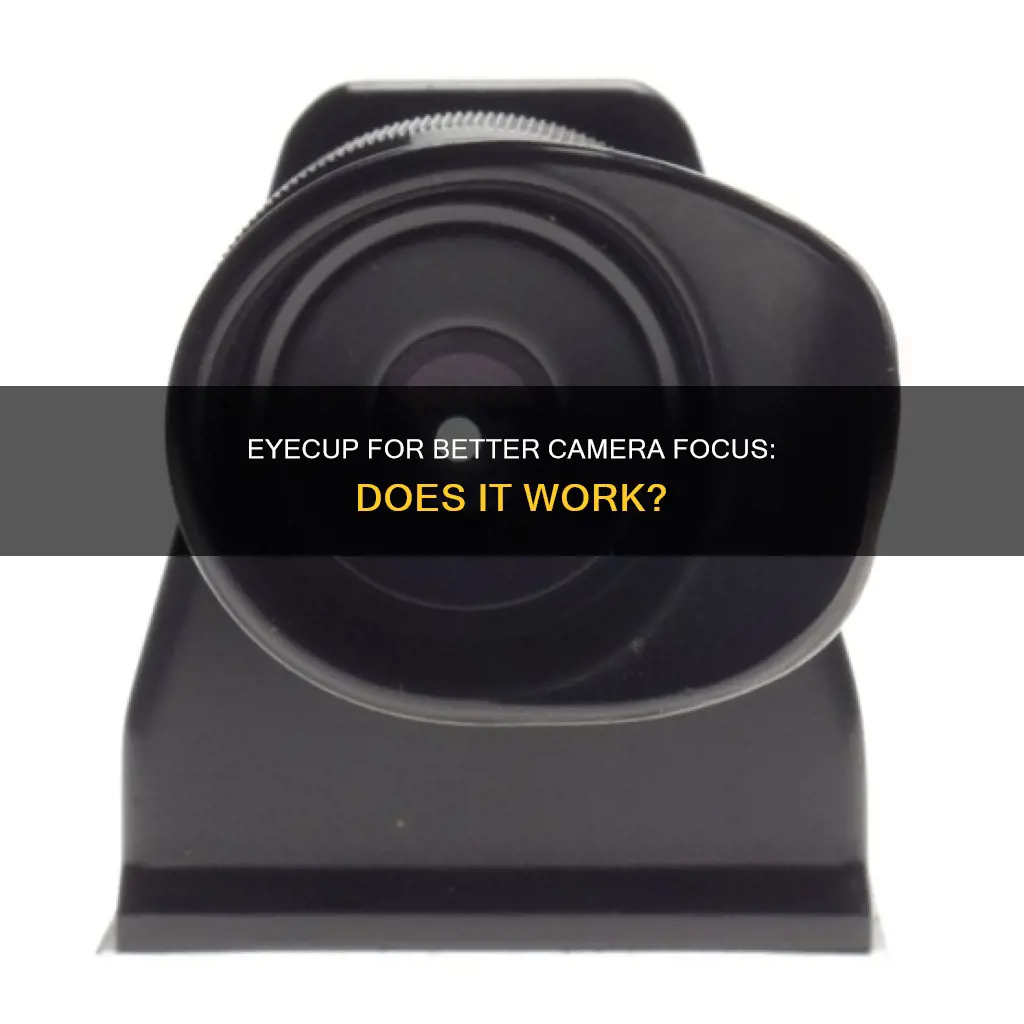
An eyecup is a contoured rubber cup attached to the eyepiece of a camera, also known as an eyepiece. Its main functions are to provide a comfortable point of contact when using the camera viewfinder, block out extraneous light to improve viewing in bright conditions, and seal the viewfinder against the user's eye in the rain. Eyecups also provide mechanical protection to the viewfinder optics and act as a soft bumper for eyewear users. They are typically included with most modern cameras but can be purchased separately as replacements or upgrades.
| Characteristics | Values |
|---|---|
| Main Function | Provides a comfortable point of contact when using the camera viewfinder |
| Light Shielding | Shields eyes from stray light and keeps it out of the viewfinder of the camera |
| Rain Protection | Seals the viewfinder against the eye in the rain |
| Mechanical Protection | Protects the viewfinder optics and acts as a soft bumper for eyewear users |
| Material | Soft, pliable rubber |
| Attachment | Easily attached and removed |
| Diopter Adjustment | Correction elements can be attached in place of the eyecup to adjust the diopter to individual requirements |
| Magnification | Magnification eyecups provide an enlarged view of the viewfinder image |
| Anti-Fog | Anti-fog eyecups feature a coated glass element to prevent fogging and condensation |
| Heated | Heated eyecups are available for some camera models to prevent fogging and freezing |
What You'll Learn
- Eyecups can block out extraneous light, improving viewing in bright conditions
- They can help seal the viewfinder against your eye in the rain
- Eyecups can act as a soft bumper for eyewear users
- They can provide mechanical protection to the viewfinder optics
- Some eyecups have a magnifying function, useful for critical focusing with manual focus lenses

Eyecups can block out extraneous light, improving viewing in bright conditions
Eyecups are a valuable accessory for photographers, offering a range of benefits that enhance the image-capturing experience. One of their key functions is to block out extraneous light, significantly improving viewing in bright conditions.
An eyecup is typically a contoured rubber cup attached to the eyepiece of a camera. It serves as a comfortable point of contact between the user's eye and the camera's viewfinder. However, its role in light blocking is equally important. By shielding the eye from stray light, the eyecup ensures that only the intended light entering through the camera's lens reaches the eye. This is especially advantageous when shooting in bright environments, as it prevents glare and improves the clarity of the image seen through the viewfinder.
The light-blocking ability of eyecups is also beneficial for photographers who wear glasses. The eyecup's design helps keep stray light from reaching the glasses, ensuring that the photographer can see clearly through the viewfinder without the glasses reflecting or refracting light in a way that interferes with their vision. This is particularly useful for eyeglass wearers who may struggle to get their eye close enough to the viewfinder due to the glasses' frame or lenses.
Additionally, some eyecups are designed to protrude further from the back of the camera, providing extended eye relief. This feature not only enhances viewing comfort but also helps block out more light, ensuring that the photographer can focus solely on the image in the viewfinder without any distractions.
Eyecups with light-blocking capabilities are commonly found on optical instruments such as binoculars and telescopes, in addition to cameras. They are often made of soft rubber, which can be folded away or removed if desired. However, higher-quality options may feature adjustable plastic or metal eyecups, providing a more durable solution for blocking extraneous light.
Outdoor Game Motion Cameras: How Long Do Batteries Really Last?
You may want to see also

They can help seal the viewfinder against your eye in the rain
An eyecup is a contoured rubber cup attached to the eyepiece of a camera. It provides a comfortable point of contact when using the camera viewfinder. Eyecups are useful in a variety of ways, one of which is helping to seal the viewfinder against your eye in the rain.
Eyecups are typically made of soft, pliable rubber, which makes them comfortable but also prone to wear and tear. This material is ideal for creating a tight seal around the camera's viewfinder, preventing water from entering and causing damage. This is especially useful for photographers who shoot in rainy or wet conditions, as it allows them to continue using their camera without worrying about water damage.
In addition to sealing out moisture, eyecups also block extraneous light, improving viewing in bright conditions. This feature is particularly beneficial when shooting outdoors, as it helps photographers see their subjects more clearly through the viewfinder. The eyecup contours to the user's face, creating a comfortable seal that blocks out unwanted light and rain.
The rubber material of the eyecup also serves as a soft bumper for eyewear users. It protects glasses or sunglasses from scratching or other damage while using the camera. This dual functionality of the eyecup makes it a valuable accessory for photographers who wear glasses and often shoot in challenging weather conditions.
Most modern photographic and cine cameras come with an eyecup already installed. However, if you need to replace a lost or damaged eyecup, they are usually available directly from the camera manufacturer. It is important to note that eyecups are typically not compatible across different camera brands and product lines, so finding the correct size and model is crucial.
Action Camera Batteries: Are They Interchangeable?
You may want to see also

Eyecups can act as a soft bumper for eyewear users
An eyecup, when relating to photographic equipment, is typically a contoured rubber cup attached to the eyepiece of a camera. Its main function is to provide a comfortable point of contact when using the camera viewfinder. Eyecups also block extraneous light to improve viewing in bright conditions and help seal the viewfinder against your eye in the rain.
Some cameras, such as Nikon, provide a large eyecup that attaches to the existing eyepiece, making the rubber portion larger so that it covers the lens of the eyeglasses. This is a simple solution that works well for many photographers who wear glasses.
Eyecups can also be retracted or partially retracted to accommodate eyeglass users when using binoculars. This allows them to see the full field of view without black rings forming on the edges.
Cleaning Corroded Camera Battery Terminals: DIY Guide
You may want to see also

They can provide mechanical protection to the viewfinder optics
An eyecup is typically a contoured rubber cup attached to the eyepiece of a camera, providing a comfortable point of contact when using the camera viewfinder. Eyecups are usually made of soft, pliable rubber, which makes them prone to wear and damage. They can also get soiled with use, so they are designed to be easily detached from the camera.
Eyecups provide mechanical protection to the viewfinder optics in several ways. Firstly, they can act as a soft bumper for eyewear users, preventing glasses from getting scratched or damaged while using the camera. This is especially useful for photographers who need to wear glasses to see clearly through the viewfinder.
Secondly, eyecups block extraneous light from entering the viewfinder, improving viewing in bright conditions. This not only enhances the user's viewing experience but also helps to prevent stray light from affecting the camera's light meter and exposure settings. By sealing the viewfinder against the eye, eyecups ensure that the camera's light meter receives the correct amount of light, resulting in accurate exposure settings.
Additionally, eyecups help to protect the viewfinder optics from physical damage. They provide a layer of cushioning, reducing the risk of accidental impacts or scratches on the viewfinder glass. This protection is especially important for cameras without built-in viewfinder protection, such as some vintage or film SLR models.
Overall, eyecups play a crucial role in safeguarding the viewfinder optics and enhancing the overall user experience when operating a camera.
Camera Battery Exhausted: What to Expect and Why
You may want to see also

Some eyecups have a magnifying function, useful for critical focusing with manual focus lenses
Eyecups, also known as eyepieces, are typically made of rubber and attached to the eyepiece of a camera. They serve multiple purposes, including providing a comfortable point of contact with the camera viewfinder, blocking stray light, and protecting the viewfinder optics. Some eyecups also have a magnifying function, which is useful for critical focusing with manual focus lenses.
The magnifying eyecups provide an enlarged view of the viewfinder image, aiding in precise manual focusing. This is particularly beneficial for photographers using manual focus lenses or engaging in macro photography. The Nikon DK-17M 1.2x Magnifying Eyepiece, for instance, offers a magnified view of the viewfinder image, making it easier for users to achieve critical focus. Similarly, the Olympus Eyecup ME-1 Magnifier increases the viewfinder performance by providing views 1.2 times larger than normal, improving the ease of focusing and framing.
The Pentax O-ME53 Magnifying Eyecup is another example of a magnifying eyecup that works with Pentax DSLR cameras, offering 1.2 times magnification. This accessory is particularly useful for critical focusing in macro photography and when using manual focus lenses.
While magnifying eyecups enhance manual focusing, they do have some limitations. Users may experience vignetting or difficulty reading information displays along the edges of the viewfinder due to the increased magnification. Therefore, it is recommended to test different options before purchasing to ensure compatibility with one's camera and usage needs.
Olympus Pen Camera: Where Are They Manufactured?
You may want to see also
Frequently asked questions
An eyecup is a contoured rubber cup attached to the eyepiece of a camera. It provides a comfortable point of contact when using the camera viewfinder. It also blocks out extraneous light and helps seal the viewfinder against your eye in the rain.
An eyecup can be useful if you never use the back monitor of your camera to take pictures. It can also help prevent skin prints on the viewfinder glass and protect your eyewear from damage.
To attach an eyecup, align the bottom side with the viewfinder and push the top edge of the eyepiece cup in to secure it.







